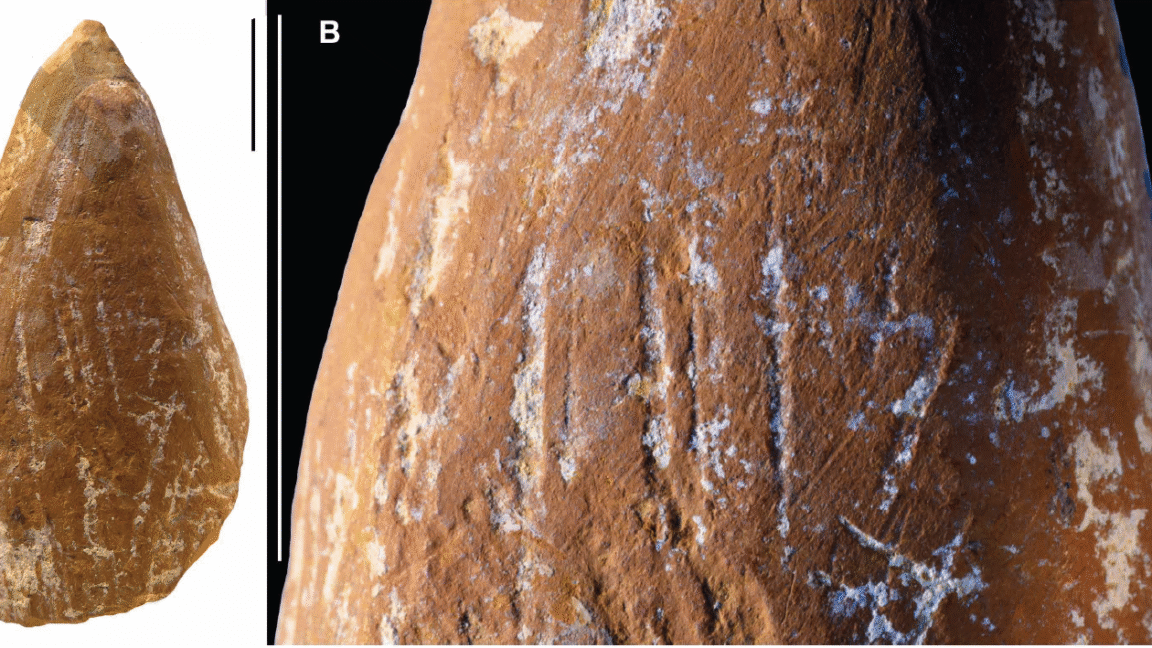Science
Neanderthals Crafted Ochre Crayons, Study Reveals Artistic Skill

Recent research indicates that Neanderthals utilized ochre to create crayons, marking a significant discovery in understanding their artistic capabilities. Archaeologists uncovered two ochre artifacts at ancient rock shelters near Bilohirsk, Crimea, dating back approximately 47,000 years. These finds suggest that Neanderthals not only had practical uses for ochre but also engaged in creative expression.
Excavations at the sites, where Neanderthals lived between 100,000 and 33,000 years ago, revealed dozens of ochre pieces. Many of these chunks displayed signs of wear, indicating they were used to extract various pigments. The iron-rich mineral, ochre, served multiple purposes, including as a pigment for art, a component in adhesives for tools, and even for tanning animal hides.
Evidence of Artistic Intent
The analysis, led by researcher D’Errico and his team, involved employing X-ray fluorescence and scanning electron microscopy on 16 ochre samples. Among these, two pieces from a specific site, named Zaskalnaya V, stood out due to their distinct shaping and wear patterns. One artifact, measuring 44.8 millimeters in length and 23.3 millimeters in width, exhibited characteristics of a crayon, including a pointed tip that showed signs of intentional sharpening.
D’Errico noted in his findings that the combination of shaping and wear strongly indicates these tools were used for drawing or marking on soft surfaces. While the fragile nature of the ochre limits specific material identification—whether it was used on animal hides, human skin, or stone—the study opens avenues for future experimental exploration to better understand the context of their use.
A third piece from Zaskalnaya V, a flat chunk of orange ochre, featured deep, parallel lines etched into its surface, suggesting it was carried and handled extensively. The polished state of the lines hints at prolonged use and care, possibly indicating a cultural significance beyond mere practicality.
Neanderthals and Cultural Complexity
This discovery contributes to a growing body of evidence that Neanderthals engaged in symbolic practices. Previously viewed as lacking the cognitive flexibility of modern humans, the findings in Crimea demonstrate that Neanderthals had a complex cultural life. Other notable archaeological evidence includes 57,000-year-old finger marks on cave walls in France and 114,000-year-old ochre-painted shells found in Spain.
The study highlights that ochre’s use likely extended beyond utilitarian functions, as humans generally associate colors with cultural meanings. D’Errico and his colleagues argue that the long-term use of ochre would have naturally led to the development of aesthetics or symbolic meanings attached to the colors.
Neanderthals may have used color to convey messages or signify identities within their communities. As noted by D’Errico, while the specific meanings remain speculative, the evidence suggests that these early humans engaged in cultural practices that were rich and varied.
The implications of this research are profound. They affirm that Neanderthals were not only intelligent but also innovative, possessing a cultural sophistication that parallels early human societies. The findings underscore the shared impulse to create art, a trait deeply rooted in our evolutionary history.
This study was published in the journal Science Advances in March 2025, adding to the ongoing discourse about Neanderthal capabilities and cultural expressions. The evolving narrative challenges traditional views of Neanderthals, painting a picture of a species that was much more than a primitive counterpart to modern humans.
-

 Science2 months ago
Science2 months agoToyoake City Proposes Daily Two-Hour Smartphone Use Limit
-

 Health2 months ago
Health2 months agoB.C. Review Reveals Urgent Need for Rare-Disease Drug Reforms
-

 Top Stories2 months ago
Top Stories2 months agoPedestrian Fatally Injured in Esquimalt Collision on August 14
-

 Technology2 months ago
Technology2 months agoDark Adventure Game “Bye Sweet Carole” Set for October Release
-

 World2 months ago
World2 months agoJimmy Lai’s Defense Challenges Charges Under National Security Law
-

 Technology2 months ago
Technology2 months agoKonami Revives Iconic Metal Gear Solid Delta Ahead of Release
-

 Technology2 months ago
Technology2 months agoSnapmaker U1 Color 3D Printer Redefines Speed and Sustainability
-

 Technology2 months ago
Technology2 months agoAION Folding Knife: Redefining EDC Design with Premium Materials
-

 Technology2 months ago
Technology2 months agoSolve Today’s Wordle Challenge: Hints and Answer for August 19
-

 Business2 months ago
Business2 months agoGordon Murray Automotive Unveils S1 LM and Le Mans GTR at Monterey
-

 Lifestyle2 months ago
Lifestyle2 months agoVictoria’s Pop-Up Shop Shines Light on B.C.’s Wolf Cull
-

 Technology2 months ago
Technology2 months agoApple Expands Self-Service Repair Program to Canada









